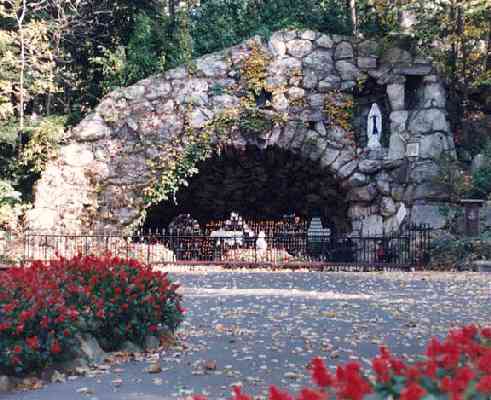
Notre Dame's Grotto / by Dorothy V. Corson


The Symbolism of Stone
Carl Jung, in his Man And His Symbols,(246) makes these very interesting references to the symbolism of the stone in religion:
Biblical references to the "stone" are numerous. "Christ is the stone that the builders rejected which became head of the corner."(Luke XX:17). Christ is also called the spiritual rock from which the water of life springs." (I Cor. X:4). Many religions use a stone to signify God or to mark a place of worship. The holiest sanctuary of the Islamic world is the Ka'abe, the black stone in Mecca to which all pious Moslems hope to make their pilgrimage.
From the Bible: "Like living stones, let yourselves be built into a spiritual house . . ." 1 Peter 2:5.
Very few people would not be able to relate to this Jung comment:
"Many people cannot refrain from picking up stones of a slightly unusual color or shape and keeping them, [as shells are picked up at the seashore], without knowing why they do. It is as if the stone held a mystery in it that fascinates them. Men have collected stones since the beginning of time and have apparently assumed that certain ones were the containers of the the spirit of the life-force with all its mystery."
The ancient Germans, for instance, believed that the spirits of the dead continued to live in their tombstones. The custom of placing stones on graves may spring partly from the symbolic idea that something eternal of the dead person remains which can be most fittingly represented by a stone."
In some cultures, when visiting a cemetery a stone is placed on the grave in the belief that the dead loved one will know you have been there.
The significance of the black stone at the Grotto, and the attraction it has for those who regularly visit the Grotto, was also explained in Jung's book:
"The stone symbolized something permanent that can never be lost or dissolved, something eternal that some have compared to the mystical experience of God within one's own soul. It symbolizes what is perhaps the simplest and deepest experience, the experience of something eternal that man can have in those moments when he feels immortal and unalterable."
The Grotto at Notre Dame must inspire just such feelings in many people who visit there. As Tom Dooley described it, there is "something else" there, a special feeling, that is a different personal experience for each person drawn there by the spirit of the place.
On several other occasions, people have asked about it. Many times since learning of the larger black stone, and having told others about it, the wish that more people were aware of it has been especially strong.
One day, in visiting the Grotto and being drawn to the black stone, a glint of gold sparkled in the sunshine. Like an answered prayer, there appeared over the large black stone the first plaque on the Grotto in almost 40 years. A small one inch by four inch plaque. On it, were the simple words, Stone From Lourdes France. It had not been there two weeks before. Someone else must have wondered about it too, and decided that it should be marked for others.
For many years additional plaques have not been allowed at the Grotto. How it was accomplished only God knows, but seeing it there is bound to be a happy surprise to many other visitors to the Grotto who were not aware of it before. Rest assured, these fingers will never touch the Lourdes stone again without thinking of, and blessing, the person who arranged for it to be there.